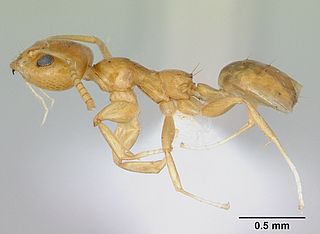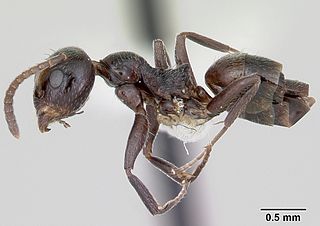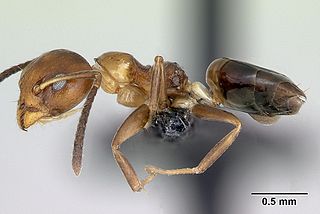
Xymmer is a genus of ant in the subfamily Amblyoponinae containing the single species Xymmer muticus.

Phrynoponera is a strictly Afrotropical genus of ants in the subfamily Ponerinae.

Pseudoponera is a small genus of ponerine ants. The genus was described by Emery in 1900.

Axinidris bidens is a species of ant in the genus Axinidris. Described by Shattuck in 1991, the species is endemic to the Central African Republic, Ghana and Kenya.

Axinidris gabonica is a species of ant in the genus Axinidris. Described by Snelling in 2007, the species is known to inhabit forests in Gabon.
Axinidris ghanensis is a species of ant in the genus Axinidris. Described by Shattuck in 1991, the species is endemic to Ghana and Uganda, based on two collections.
Axinidris hylekoites is a species of ant in the genus Axinidris. Described by Shattuck in 1991, the species is endemic to Ghana, where it was only observed in a rotten tree branch.

Axinidris hypoclinoides is a species of ant in the genus Axinidris. Described by Santschi in 1919, collected specimens are only known to be from forestry regions in several African countries.
Axinidris icipe is a species of ant in the genus Axinidris. Described by Snelling in 2007, the species is known to be from Kenya.
Axinidris hylekoites is a species of ant in the genus Axinidris. Described by Shattuck in 1991, the species is endemic to Nigeria, where it was found alongside a road within some vegetation.

Axinidris lignicola is a species of ant in the genus Axinidris. Described by Snelling in 2007, the species is known to be from South Africa, found in a dead tree trunk.

Axinidris luhya is a species of ant in the genus Axinidris. Described by Snelling in 2007, the species is known to be from Kenya, found on vegetation in forests.

Axinidris mlalu is a species of ant in the genus Axinidris. Described by Snelling in 2007, the species is known to be from the Central African Republic, found on vegetation in rainforests.
Axinidris namib is a species of ant in the genus Axinidris. Described by Snelling in 2007, the species is endemic to Namibia.
Axinidris occidentalis is a species of ant in the genus Axinidris. Described by Shattuck in 1991, the species is endemic to Liberia, and is known to live in habitats that other Axinidris ants prefer.
Axinidris okekai is a species of ant in the genus Axinidris. Described by Snelling in 2007, the species is endemic to Kenya, where specimens have been collected from vines.
Axinidris palligastrion is a species of ant in the genus Axinidris. Described by Shattuck in 1991, the species is endemic to Ghana, where they were found foraging on trees.
Axinidris stageri is a species of ant in the genus Axinidris. Described by Snelling in 2007, the species is endemic to Tanzania.










